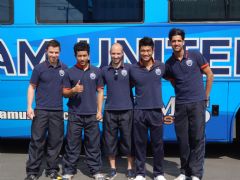After arriving in Seoul on Monday morning for our Asian Champions League
game tonight, the Buriram United team has spent valuable time recovering from
the effects of the long travel & subsequent sleep disturbance.
As energy
levels began to return, we trained last night at the stadium, which is just as
imposing as I remember from my visit with Spurs for the Peace Cup final against
FC Lyonnais in 2005.
My initial
impression of the city, in the short time we have been here, is a very positive
one & the team walks through the local park have given us some spectacular
views of the central business district.
The aim of
our team walks has been to promote recovery with gentle, low impact exercise
& at the end of the walks we have spent a few minutes stretching. My
reasoning behind incorporating stretches into this activity is to restore
length to the soft tissue that has been resting in a fixed position for long
periods on flights & bus transfers. In addition, the oxygenation of
the tissues & venous return should be enhanced through the combined period
of walking & stretching.
During my
days working with the Football Association, we discussed & debated the role
of stretching in great depth. In fact it
was one of the most common points of enquiry from coaches on the courses we
ran.
Since
returning to work in football with Buriram United, I have found myself
revisiting the information we used to present all those years ago, in order to
assess the efficacy of the warm ups I am seeing in the Thai Premier League.
I have seen several teams out here that still incorporate long periods of
static stretching into their pre-match warm-up routines.
I have
reviewed several of the papers that have been published & the evidence
would suggest that this is not optimal practice.
For clarity,
I am initially going to define a few terms:
1) Static
Stretching
Static
stretching is mostly performed as a passive stretch, whereby the target muscle
tendon units are not actively recruited & are stretched by applying an
external force. Usually this controlled stretch is sustained for several
seconds, with the aim of increasing the available range of motion.
2) Dynamic
Stretching
If
the joints are moved through the available range of motion with a controlled
speed, this is usually described as dynamic stretching, which involves the
antagonist muscle groups being recruited in a coordinated manner to provide the
force of stretch.
3) Ballistic Stretching
Whilst ballistic stretching is obviously a form of
dynamic stretching, the differentiation is often made because the movement
through the range of motion is faster, nearly explosive & utilises the so
called stretch-reflex where muscle spindles & golgi tendon organs are
activated.
If the aim of the exercise is to increase the range
of motion of a joint, then passive stretching is often deemed the exercise of
choice & the majority of the research that I have read, suggests these
should be performed at least one to three times a week, with stretches applied
for at least 20-30 seconds. Static stretching might be more suited in
football in the post-activity period (exercise/game), yet in the past, & as
I have seen in recent weeks, it has been used in warm-ups too.
There is a body of research, however, that
indicates there are limitations to such application. If the number of
repetitions, sets or duration of stretch are too great, the mean & peak
force production of the muscles may be compromised (Rossi et al, 2010); motor
performance skills & agility performance may be detrimentally impacted
(Andrejic et al, 2012 & Amiri-Khorasani et al, 2010); running velocity may
be negatively affected (Nelson et al, 2005 & Rountas et al, 2006) &
explosive jump capabilities may be reduced (Faigenbaum et al, 2005).
It must also be remembered that if the passive
range is increased without addressing the control of movement in the extremes
of joint range, then a discrepancy between active & passive range can
develop, which can result in an increased risk of injury.
In contrast, the muscle recruitment, proprioceptive
feedback & isotonic demands of dynamic stretching, make it an ideal form of
exercise in preparation for practice or game play. In addition both
dynamic & ballistic stretches can be adapted to incorporate sport specific
movements, such as kicking, cutting or jumping for a footballer.
Dynamic stretching has been shown to have a
positive influence on sprint times (Saoulidis et al, 2006) & jump scores
(Carvalho et al, 2012). Even more interestingly decreases in blood
lactate concentration, increases in VO2 max & increases in time to
exhaustion have also been demonstrated after dynamic warm-ups in comparison to
static stretching (Kaur et al, 2008).
Given the increased rate of movement in ballistic
stretching, this should be introduced as the temperature & viscosity of the
soft tissue increases as the stretching progresses.
To review the papers in more detail, click on the
links below:
Carvalho, F.L.P.
et al (2012). Acute effects of a warm-up including active, passive &
dynamic stretching on vertical jump performance. J of Strength &
Cond Res; 26(9): pp 2447-2452

